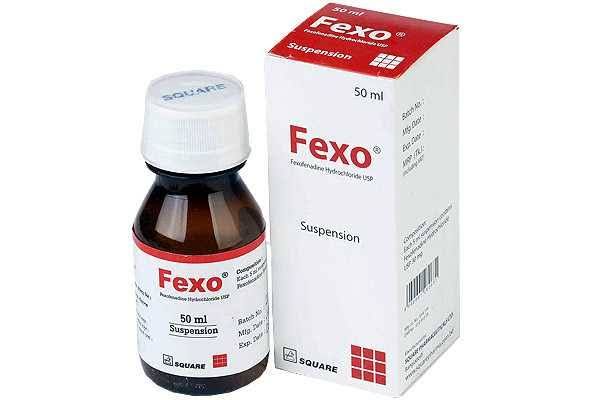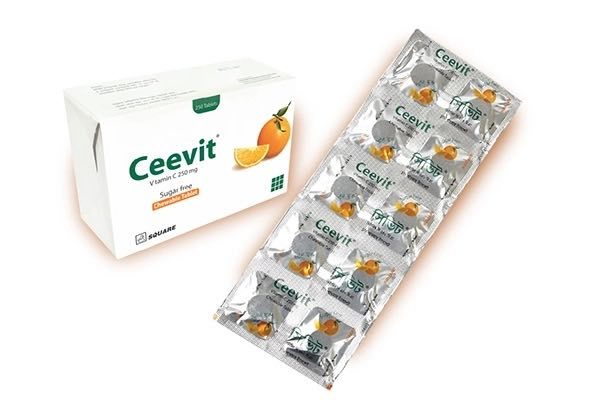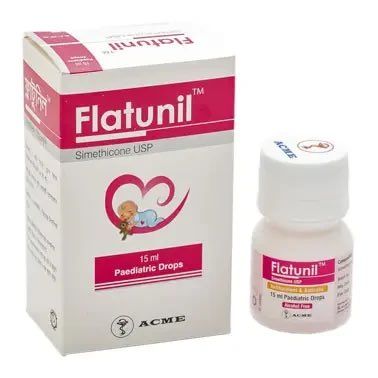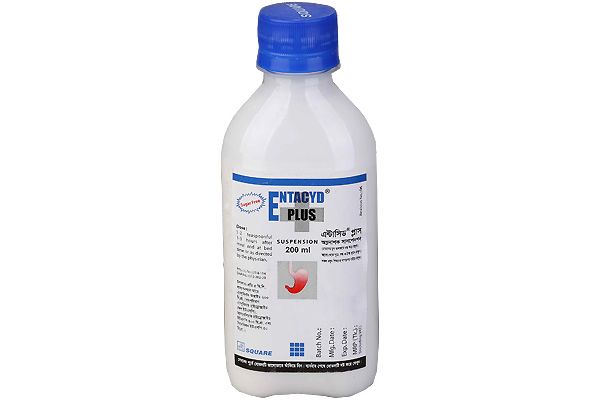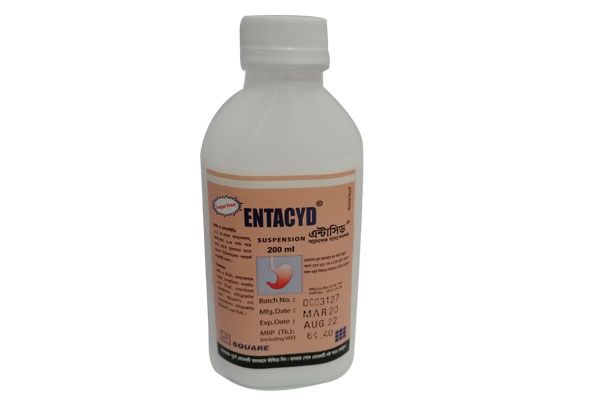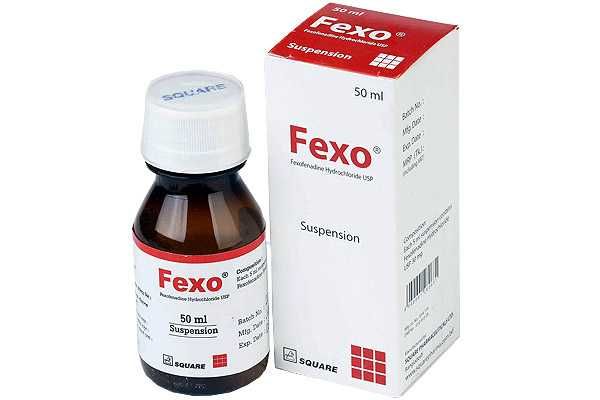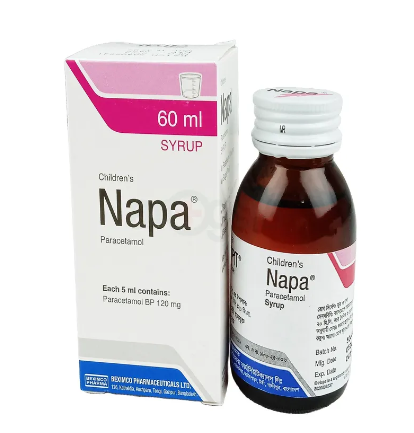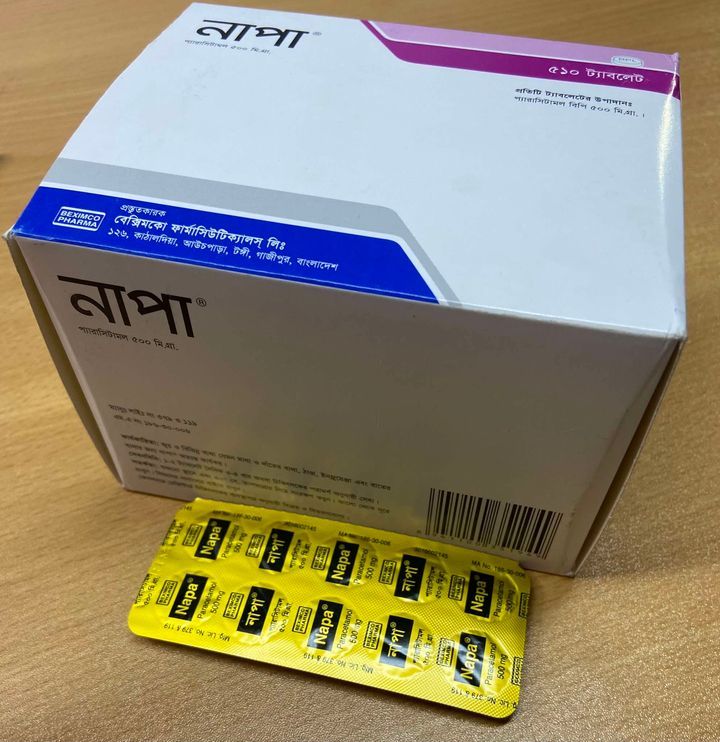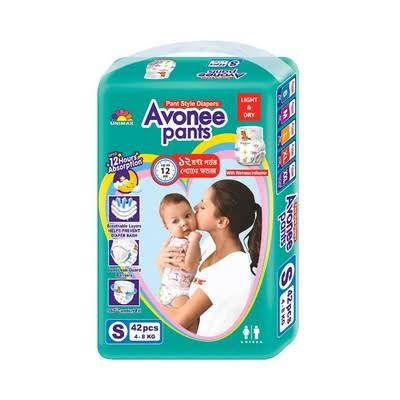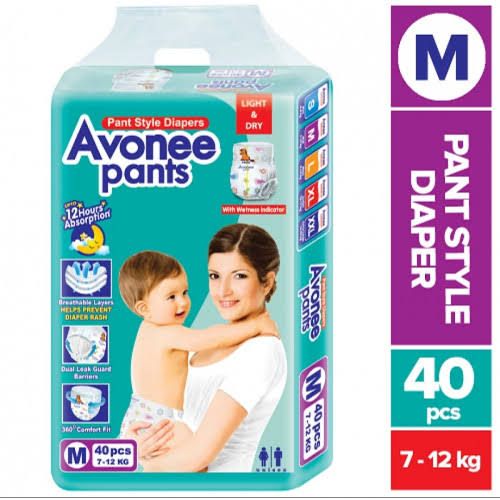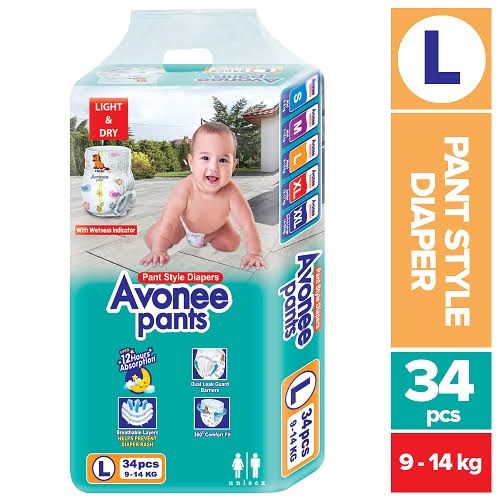Fexo Suspension 30mg/50ml
Indications Allergic rhinitis: Fexo is indicated for the relief of symptoms associated with seasonal and perennial allergic rhinitis, in adults and children 12 years of age and over. Symptoms treated effectively include sneezing, rhinorrhea, lacrimation, itchy, red eyes and itchy nose/palate/throat ... Read more Fexocold-fexorush - MedEx campaign banner Airway-sharpkil - MedEx campaign banner Pharmacology The H1 histamine receptor is responsible for mediating hypersensitivity and allergic reactions. Exposure to allergen results in the degranulation of mast cells and basophils, which then release histamine and other inflammatory mediators. Histamine binds to, and activates, H1 receptors, which results in the further release of pro-inflammatory cytokines, such as interleukins, from basophils and mast cells. These downstream effects of histamine binding are responsible for a wide variety of allergic symptoms, such as pruritus, rhinorrhea, and watery eyes. Fexofenadine is considered an "inverse agonist" of the H1 receptor because it binds to and stabilizes the inactive form of the receptor, preventing its activation and subsequent downstream effects. It has a potent and selective affinity for H1 receptors, and there is no evidence that it carries antidopaminergic, antiserotonergic, anticholinergic, sedative, or adrenergic blocking activity. Fexofenadine does not cross the blood-brain barrier and thus is unlikely to cause significant CNS effects. Dosage & Administration Allergic Rhinitis- Adults and children 12 years and older: Tablet: 60 mg twice daily or 120 mg once daily or 180 mg once daily In case of impaired renal function: 60 mg once daily Children from 6 to 11 years: Tablet: 30 mg twice daily or 60 mg once daily In case of impaired renal function: 30 mg once daily Children from 2 to 11 years Suspension: 30 mg or 5 ml twice daily In case of impaired renal function: 30 mg or 5 ml once daily Chronic Idiopathic Urticaria- Adults and children 12 years and older: Tablet: 60 mg twice daily or 120 mg once daily or 180 mg once daily In case of impaired renal function: 60 mg once daily Children from 6 to 11 years: Tablet: 30 mg twice daily or 60 mg once daily In case of impaired renal function: 30 mg once daily Children from 6 months to less than 2 years: Suspension: 15 mg or 2.5 ml (1/2 tsp) twice daily In case of impaired renal function: 15 mg or 2.5 ml (1/2 tsp) once daily Children from 2 to 11 years: Suspension: 30 mg or 5 ml (1 tsp) twice daily In case of impaired renal function: 30 mg or 5 ml (1 tsp) once daily * চিকিৎসকের পরামর্শ মোতাবেক ঔষধ সেবন করুন' Interaction Fexo does not undergo hepatic biotransformation and therefore will not interact with other medicinal products through hepatic mechanisms. Coadministration of Fexo with erythromycin or ketoconazole has been found to result in a 2-3 times increase in the level of fexofenadine in plasma. The changes were not accompanied by any effects on the QT interval and were not associated with any increase in adverse reactions compared to the medicinal products given singly. No interaction between fexofenadine and omeprazole was observed. However, the administration of an antacid containing aluminium and magnesium hydroxide gels 15 minutes prior to Fexo caused a reduction in bioavailability, most likely due to binding in the gastrointestinal tract. It is advisable to leave 2 hours between administration of Fexo and aluminium and magnesium hydroxide containing antacids. Contraindications Contraindicated in patients with known hypersensitivity to Fexofenadine Hydrochloride or any of its ingredients. Side Effects The following frequency rating has been used, when applicable: Very common ≥1/10; Common ≥1/100 and <1/10; Uncommon ≥1/1,000 and <1/100; Rare ≥1/10,000 and <1/1,000; Very rare <1/10,000 and not known (frequency cannot be estimated from the available data). Within each frequency grouping, undesirable effects are presented in order of decreasing seriousness. In adults, the following undesirable effects have been reported in clinical trials, with an incidence similar to that observed with placebo: Nervous system disorders- Common: headache, drowsiness, dizziness; Gastrointestinal disorders- Common: nausea; General disorders and administration site conditions- Uncommon: fatigue. In adults, the following undesirable effects have been reported in post-marketing surveillance. The frequency with which they occur is not known (cannot be estimated from available data): Immune system disorders- hypersensitivity reactions with manifestations such as angioedema, chest tightness, dyspnoea, flushing and systemic anaphylaxis; Psychiatric disorders- insomnia, nervousness, sleep disorders or nightmares/excessive dreaming (paroniria); Cardiac disorders- tachycardia, palpitations; Gastrointestinal disorders- diarrhea; Skin and subcutaneous tissue disorders- rash, urticaria, pruritus Pregnancy & Lactation There are no adequate data from the use of Fexofenadine hydrochloride in pregnant women. Limited animal studies do not indicate direct or indirect harmful effects with respect to effects on pregnancy, embryonal/foetal development, parturition or postnatal development. Fexofenadine hydrochloride should not be used during pregnancy unless clearly necessary. There are no data on the content of human milk after administering Fexofenadine hydrochloride. However, when Terfenadine was administered to nursing mothers Fexofenadine was found to cross into human breast milk. Therefore, Fexofenadine hydrochloride is not recommended for mothers breast-feeding their babies. No human data on the effect of Fexofenadine hydrochloride on fertility are available. In mice, there was no effect on fertility with Fexofenadine hydrochloride treatment. Precautions & Warnings As with most new medicinal products there is only limited data in the older people and renally or hepatically impaired patients. Fexo should be administered with care in these special groups. Patients with a history of or ongoing cardiovascular disease should be warned that, antihistamines as a medicine class, have been associated with the adverse reactions, tachycardia and palpitations. Effects on ability to drive and use machines: On the basis of the pharmacodynamic profile and reported adverse reactions it is unlikely that Fexo tablets will produce an effect on the ability to drive or use machines. In objective tests, Fexo has been shown to have no significant effects on central nervous system function. This means that patients may drive or perform tasks that require concentration. However, in order to identify sensitive people who have an unusual reaction to medicinal products, it is advisable to check the individual response before driving or performing complicated tasks. Use in Special Populations Renal and hepatic impaired patient: The pharmacokinetics of fexofenadine are altered in individuals with renal impairment. Based on increases in bioavailability and half-life, a dose of 60 mg once daily is recommended as the starting dose in patients with decreased renal function. Moderate to severe hepatic disease does not affect the pharmacokinetics of fexofenadine substantially. Elderly patient: Adverse events were similar in this group compared to patients under 65 years of age. Nevertheless, the pharmacokinetics of fexofenadine is altered (increased bioavailability) in individuals over 65 years of age. Overdose Effects Dizziness, drowsiness, fatigue and dry mouth have been reported with overdose of Fexo. Single doses up to 800 mg and doses up to 690 mg twice daily for 1 month or 240 mg once daily for 1 year have been administered to healthy subjects without the development of clinically significant adverse reactions as compared with placebo. The maximum tolerated dose of Fexo has not been established. Standard measures should be considered to remove any unabsorbed medicinal product. Symptomatic and supportive treatment is recommended. Haemodialysis does not effectively remove Fexo from blood. Therapeutic Class Non-sedating antihistamines Storage Conditions Keep in a dry place away from light and heat. Keep out of the reach of children. Chemical Structure Molecular Formula : C32H39NO4 Chemical Structure : Chemical Structure of Fexofenadine Hydrochloride Common Questions about Fexo 30 mg/5 ml Suspension What is Fexo 30 mg/5 ml Suspension? Fexo 30 mg/5 ml Suspension is an antihistamine. It works by blocking histamine that the body makes during an allergic reaction. What are the uses of Fexo 30 mg/5 ml Suspension? Fexo 30 mg/5 ml Suspension is used for the treatment of allergic rhinitis and urticaria. It relieves allergy symptoms such as runny nose, itching eyes/nose, sneezing, hives, and itching. What are the Side Effects of Fexo 30 mg/5 ml Suspension? Fexo 30 mg/5 ml Suspension has some reported side effects such as Vomiting, Headache, Coughing, Diarrhea, Painful menstruation, Pain in the arms and legs, Hives and redness of skin, Swelling of face, lips, eyelids, tongue, hands and feet. What are the instructions for storage and disposal Fexo 30 mg/5 ml Suspension? Fexo 30 mg/5 ml Suspension should be kept in a cool dry place and in its original pack. Make sure this medication remains unreachable to children and pets. Can Fexo 30 mg/5 ml Suspension make you sleepy? Yes, Fexo 30 mg/5 ml Suspension can make you feel sleepy, infect sleepiness is a common side effect of this medicine. Can you overdose on Fexo 30 mg/5 ml Suspension? Do not take an overdose of Fexo 30 mg/5 ml Suspension as this can cause adverse reactions and may increase the risk of side effects like dizziness, drowsiness, fatigue, and dry mouth. How quickly does Fexo 30 mg/5 ml Suspension work? Fexo 30 mg/5 ml Suspension starts working within 1 hour of consuming it. The peak benefit of Fexo 30 mg/5 ml Suspension is observed within 6 hours. Does Fexo 30 mg/5 ml Suspension relieve symptoms of outdoor and indoor allergies? Yes, Fexo 30 mg/5 ml Suspension can help relieve symptoms that may be caused by outdoor and indoor allergens such as upper respiratory allergies, hay fever, watery eyes, runny nose, and sneezing, or itching of the nose or throat. How to cope with dizziness caused by Fexo 30 mg/5 ml Suspension? Take some rest after taking Fexo 30 mg/5 ml Suspension if you feel dizzy or sleep. Do not use heavy machinery or drive and move very slowly. Exercise caution and if there is extreme dizziness, then consult a doctor as soon as possible. Can I take antacids while taking Fexo 30 mg/5 ml Suspension? Fexo 30 mg/5 ml Suspension should not be used in combination with antacids as the interaction between them can result in a decreased absorption of Fexo 30 mg/5 ml Suspension. How should I take Fexo 30 mg/5 ml Suspension? Fexo 30 mg/5 ml Suspension should be taken in dose and duration as recommended by the doctor. Do not take an overdose as this can affect your health adversely. Is there any food or drink that I need to avoid while taking Fexo 30 mg/5 ml Suspension? Do not consume juices like grapefruit juice, orange juice and apple juice if you are on the course of medication with Fexo 30 mg/5 ml Suspension. Can Fexo 30 mg/5 ml Suspension cause heart problems? Those who suffer from heart disorders should exercise caution and must look out for some other alternative of this medicine. Quick Tips Fexo 30 mg/5 ml Suspension is an antihistaminic medication. It treats allergy symptoms such as itching, swelling, and rashes by blocking the effects of a chemical messenger (histamine) in the body. Fexo 30 mg/5 ml Suspension is less likely to make you feel sleepy than some other similar medicines. Do not take Fexo 30 mg/5 ml Suspension with any fruit juices (such as apple, orange, or grapefruit) as they might make the drug less effective. Fexo 30 mg/5 ml Suspension may cause nausea. Stick to simple meals, and do not eat rich or spicy food. Avoid using antacids 30 minutes before or after taking Fexo 30 mg/5 ml Suspension. It can make it harder for your body to absorb this medication. * চিকিৎসকের পরামর্শ মোতাবেক ঔষধ সেবন করুন'
৳55.00
Flatunil Pediatric Drops
Flatulence, abdominal distention, fullness, gas and windy colic: Flatunil is an excellent and effective antiflatulent. It is used for relief of the painful symptoms of excess gas in the digestive tract. Such gas is frequently caused by excessive swallowing of air or by eating foods that disagree. Flatunil drop is especially used in infants, acts in the stomach and intestines. Thus Flatunil enables freeing and eliminating the gas more easily by belching or passing flatus. Large bowel preparation: Addition of Flatunil to a polyethylene glycol bowel preparation produces symptomatic improvement prior to investigation in the management of accidental ingestion of foaming detergents. Treatment of poisoning: Flatunil has an anecdotal use as an antifoaming agent in the management of accidental ingestion of foaming detergents. * রেজিস্টার্ড চিকিৎসকের পরামর্শ মোতাবেক ঔষধ সেবন করুন'
৳35.00
Entacyd Plus Syrup (200ml)
This is indicated for dyspepsia, hyperacidity, gastric and duodenal ulcer, gastritis; also indicated for the relief of flatulence, abdominal distention and windy colic.
৳90.00
৳90.00
Entacyd®
Indication: Hyperacidity, peptic ulcer, gastritis, heartburn, sour stomach and dyspepsia. Dosage & Administration: Two teaspoonful suspension 1-3 hours after meal and at bed time. Preparation: Entacyd® suspension : Bottle containing 200 ml suspension.
৳64.40
৳64.40
Fexo Suspension 30mg/50ml
Indications Allergic rhinitis: Fexo is indicated for the relief of symptoms associated with seasonal and perennial allergic rhinitis, in adults and children 12 years of age and over. Symptoms treated effectively include sneezing, rhinorrhea, lacrimation, itchy, red eyes and itchy nose/palate/throat ... Read more Fexocold-fexorush - MedEx campaign banner Airway-sharpkil - MedEx campaign banner Pharmacology The H1 histamine receptor is responsible for mediating hypersensitivity and allergic reactions. Exposure to allergen results in the degranulation of mast cells and basophils, which then release histamine and other inflammatory mediators. Histamine binds to, and activates, H1 receptors, which results in the further release of pro-inflammatory cytokines, such as interleukins, from basophils and mast cells. These downstream effects of histamine binding are responsible for a wide variety of allergic symptoms, such as pruritus, rhinorrhea, and watery eyes. Fexofenadine is considered an "inverse agonist" of the H1 receptor because it binds to and stabilizes the inactive form of the receptor, preventing its activation and subsequent downstream effects. It has a potent and selective affinity for H1 receptors, and there is no evidence that it carries antidopaminergic, antiserotonergic, anticholinergic, sedative, or adrenergic blocking activity. Fexofenadine does not cross the blood-brain barrier and thus is unlikely to cause significant CNS effects. Dosage & Administration Allergic Rhinitis- Adults and children 12 years and older: Tablet: 60 mg twice daily or 120 mg once daily or 180 mg once daily In case of impaired renal function: 60 mg once daily Children from 6 to 11 years: Tablet: 30 mg twice daily or 60 mg once daily In case of impaired renal function: 30 mg once daily Children from 2 to 11 years Suspension: 30 mg or 5 ml twice daily In case of impaired renal function: 30 mg or 5 ml once daily Chronic Idiopathic Urticaria- Adults and children 12 years and older: Tablet: 60 mg twice daily or 120 mg once daily or 180 mg once daily In case of impaired renal function: 60 mg once daily Children from 6 to 11 years: Tablet: 30 mg twice daily or 60 mg once daily In case of impaired renal function: 30 mg once daily Children from 6 months to less than 2 years: Suspension: 15 mg or 2.5 ml (1/2 tsp) twice daily In case of impaired renal function: 15 mg or 2.5 ml (1/2 tsp) once daily Children from 2 to 11 years: Suspension: 30 mg or 5 ml (1 tsp) twice daily In case of impaired renal function: 30 mg or 5 ml (1 tsp) once daily * চিকিৎসকের পরামর্শ মোতাবেক ঔষধ সেবন করুন' Interaction Fexo does not undergo hepatic biotransformation and therefore will not interact with other medicinal products through hepatic mechanisms. Coadministration of Fexo with erythromycin or ketoconazole has been found to result in a 2-3 times increase in the level of fexofenadine in plasma. The changes were not accompanied by any effects on the QT interval and were not associated with any increase in adverse reactions compared to the medicinal products given singly. No interaction between fexofenadine and omeprazole was observed. However, the administration of an antacid containing aluminium and magnesium hydroxide gels 15 minutes prior to Fexo caused a reduction in bioavailability, most likely due to binding in the gastrointestinal tract. It is advisable to leave 2 hours between administration of Fexo and aluminium and magnesium hydroxide containing antacids. Contraindications Contraindicated in patients with known hypersensitivity to Fexofenadine Hydrochloride or any of its ingredients. Side Effects The following frequency rating has been used, when applicable: Very common ≥1/10; Common ≥1/100 and <1/10; Uncommon ≥1/1,000 and <1/100; Rare ≥1/10,000 and <1/1,000; Very rare <1/10,000 and not known (frequency cannot be estimated from the available data). Within each frequency grouping, undesirable effects are presented in order of decreasing seriousness. In adults, the following undesirable effects have been reported in clinical trials, with an incidence similar to that observed with placebo: Nervous system disorders- Common: headache, drowsiness, dizziness; Gastrointestinal disorders- Common: nausea; General disorders and administration site conditions- Uncommon: fatigue. In adults, the following undesirable effects have been reported in post-marketing surveillance. The frequency with which they occur is not known (cannot be estimated from available data): Immune system disorders- hypersensitivity reactions with manifestations such as angioedema, chest tightness, dyspnoea, flushing and systemic anaphylaxis; Psychiatric disorders- insomnia, nervousness, sleep disorders or nightmares/excessive dreaming (paroniria); Cardiac disorders- tachycardia, palpitations; Gastrointestinal disorders- diarrhea; Skin and subcutaneous tissue disorders- rash, urticaria, pruritus Pregnancy & Lactation There are no adequate data from the use of Fexofenadine hydrochloride in pregnant women. Limited animal studies do not indicate direct or indirect harmful effects with respect to effects on pregnancy, embryonal/foetal development, parturition or postnatal development. Fexofenadine hydrochloride should not be used during pregnancy unless clearly necessary. There are no data on the content of human milk after administering Fexofenadine hydrochloride. However, when Terfenadine was administered to nursing mothers Fexofenadine was found to cross into human breast milk. Therefore, Fexofenadine hydrochloride is not recommended for mothers breast-feeding their babies. No human data on the effect of Fexofenadine hydrochloride on fertility are available. In mice, there was no effect on fertility with Fexofenadine hydrochloride treatment. Precautions & Warnings As with most new medicinal products there is only limited data in the older people and renally or hepatically impaired patients. Fexo should be administered with care in these special groups. Patients with a history of or ongoing cardiovascular disease should be warned that, antihistamines as a medicine class, have been associated with the adverse reactions, tachycardia and palpitations. Effects on ability to drive and use machines: On the basis of the pharmacodynamic profile and reported adverse reactions it is unlikely that Fexo tablets will produce an effect on the ability to drive or use machines. In objective tests, Fexo has been shown to have no significant effects on central nervous system function. This means that patients may drive or perform tasks that require concentration. However, in order to identify sensitive people who have an unusual reaction to medicinal products, it is advisable to check the individual response before driving or performing complicated tasks. Use in Special Populations Renal and hepatic impaired patient: The pharmacokinetics of fexofenadine are altered in individuals with renal impairment. Based on increases in bioavailability and half-life, a dose of 60 mg once daily is recommended as the starting dose in patients with decreased renal function. Moderate to severe hepatic disease does not affect the pharmacokinetics of fexofenadine substantially. Elderly patient: Adverse events were similar in this group compared to patients under 65 years of age. Nevertheless, the pharmacokinetics of fexofenadine is altered (increased bioavailability) in individuals over 65 years of age. Overdose Effects Dizziness, drowsiness, fatigue and dry mouth have been reported with overdose of Fexo. Single doses up to 800 mg and doses up to 690 mg twice daily for 1 month or 240 mg once daily for 1 year have been administered to healthy subjects without the development of clinically significant adverse reactions as compared with placebo. The maximum tolerated dose of Fexo has not been established. Standard measures should be considered to remove any unabsorbed medicinal product. Symptomatic and supportive treatment is recommended. Haemodialysis does not effectively remove Fexo from blood. Therapeutic Class Non-sedating antihistamines Storage Conditions Keep in a dry place away from light and heat. Keep out of the reach of children. Chemical Structure Molecular Formula : C32H39NO4 Chemical Structure : Chemical Structure of Fexofenadine Hydrochloride Common Questions about Fexo 30 mg/5 ml Suspension What is Fexo 30 mg/5 ml Suspension? Fexo 30 mg/5 ml Suspension is an antihistamine. It works by blocking histamine that the body makes during an allergic reaction. What are the uses of Fexo 30 mg/5 ml Suspension? Fexo 30 mg/5 ml Suspension is used for the treatment of allergic rhinitis and urticaria. It relieves allergy symptoms such as runny nose, itching eyes/nose, sneezing, hives, and itching. What are the Side Effects of Fexo 30 mg/5 ml Suspension? Fexo 30 mg/5 ml Suspension has some reported side effects such as Vomiting, Headache, Coughing, Diarrhea, Painful menstruation, Pain in the arms and legs, Hives and redness of skin, Swelling of face, lips, eyelids, tongue, hands and feet. What are the instructions for storage and disposal Fexo 30 mg/5 ml Suspension? Fexo 30 mg/5 ml Suspension should be kept in a cool dry place and in its original pack. Make sure this medication remains unreachable to children and pets. Can Fexo 30 mg/5 ml Suspension make you sleepy? Yes, Fexo 30 mg/5 ml Suspension can make you feel sleepy, infect sleepiness is a common side effect of this medicine. Can you overdose on Fexo 30 mg/5 ml Suspension? Do not take an overdose of Fexo 30 mg/5 ml Suspension as this can cause adverse reactions and may increase the risk of side effects like dizziness, drowsiness, fatigue, and dry mouth. How quickly does Fexo 30 mg/5 ml Suspension work? Fexo 30 mg/5 ml Suspension starts working within 1 hour of consuming it. The peak benefit of Fexo 30 mg/5 ml Suspension is observed within 6 hours. Does Fexo 30 mg/5 ml Suspension relieve symptoms of outdoor and indoor allergies? Yes, Fexo 30 mg/5 ml Suspension can help relieve symptoms that may be caused by outdoor and indoor allergens such as upper respiratory allergies, hay fever, watery eyes, runny nose, and sneezing, or itching of the nose or throat. How to cope with dizziness caused by Fexo 30 mg/5 ml Suspension? Take some rest after taking Fexo 30 mg/5 ml Suspension if you feel dizzy or sleep. Do not use heavy machinery or drive and move very slowly. Exercise caution and if there is extreme dizziness, then consult a doctor as soon as possible. Can I take antacids while taking Fexo 30 mg/5 ml Suspension? Fexo 30 mg/5 ml Suspension should not be used in combination with antacids as the interaction between them can result in a decreased absorption of Fexo 30 mg/5 ml Suspension. How should I take Fexo 30 mg/5 ml Suspension? Fexo 30 mg/5 ml Suspension should be taken in dose and duration as recommended by the doctor. Do not take an overdose as this can affect your health adversely. Is there any food or drink that I need to avoid while taking Fexo 30 mg/5 ml Suspension? Do not consume juices like grapefruit juice, orange juice and apple juice if you are on the course of medication with Fexo 30 mg/5 ml Suspension. Can Fexo 30 mg/5 ml Suspension cause heart problems? Those who suffer from heart disorders should exercise caution and must look out for some other alternative of this medicine. Quick Tips Fexo 30 mg/5 ml Suspension is an antihistaminic medication. It treats allergy symptoms such as itching, swelling, and rashes by blocking the effects of a chemical messenger (histamine) in the body. Fexo 30 mg/5 ml Suspension is less likely to make you feel sleepy than some other similar medicines. Do not take Fexo 30 mg/5 ml Suspension with any fruit juices (such as apple, orange, or grapefruit) as they might make the drug less effective. Fexo 30 mg/5 ml Suspension may cause nausea. Stick to simple meals, and do not eat rich or spicy food. Avoid using antacids 30 minutes before or after taking Fexo 30 mg/5 ml Suspension. It can make it harder for your body to absorb this medication. * চিকিৎসকের পরামর্শ মোতাবেক ঔষধ সেবন করুন'
৳55.00
৳55.00
Napa Syrup 60ml
Medicine Overview of Napa 120mg/5ml Syrup Introduction Napa 120mg/5ml is a medicine used to relieve pain and to reduce fever. It is used to treat many conditions such as headache, body ache, toothache and common cold.Napa may be prescr120mg/5ml ibed alone or in combination with another medicine. You sho... ... Show more Uses of Napa Pain relief Fever Side effects of Napa Common No common side effects seen How to use Napa Take Napa 120mg/5ml medicine in the dose and duration as advised by your doctor. Swallow it as a whole. Do not chew, crush or break it. Napa 120mg/5ml is to be taken with food. How Napa works Napa 120mg/5ml is an analgesic (pain reliever) and anti-pyretic (fever reducer). It works by blocking the release of certain chemical messengers that cause pain and fever. Napa is an analgesic (pain reliever) and anti-pyretic (fever reducer). It works by blocking the release of certain chemical messengers that cause pain and fever. What if you forget to take Napa? If you miss a dose of Napa 120mg/5ml, take it as soon as possible. However, if it is almost time for your next dose, skip the missed dose and go back to your regular schedule. Do not double the dose. Quick Tips Napa should be taken with food or milk to prevent upset stomach. Take it as per the dose and duration prescribed by your doctor. Long term use may lead to serious complications such as stomach bleeding and kidney problems. Do not take indigestion remedies (antacids) within two hours of taking Napa. Avoid consuming alcohol while taking this medicine as it can increase your risk of stomach problems. Inform your doctor if you have liver disease as your dose may need to be adjusted. Your doctor may regularly monitor your kidney function, liver function and levels of blood components if you are taking this medicine for long-term treatment. Brief Description Indication Fever, Mild to moderate pain, osteoarthritis, rheumatoid arthritis, chronic low back pain, Renal stone pain, neuropathic pain, toothache, migraine, Administration May be taken with or without food. Adult Dose Oral Mild to moderate pain and fever Tablet Adult: 1 - 2 tablets every 4 to 6 hours up to a maximum of 4 g (8 tablets) daily Extended Release (XR) Tablet Adults: 2 tablets, swallowed whole, every 6 to 8 hours (maximum of 6 tablets in any 24 hours). Syrup/Suspension: Adults: 4-8 Measuring spoonful 3-4 times daily; Rectal Suppository Adults: 500 mg-1 g every 4-6 hours to a maximum of 4 g daily. Child Dose Oral Mild to moderate pain and fever Tablet Children (6 - 12 years) : 1/2 to 1 tablet 3 to 4 times daily Extended Release (XR) Tablet Children over 12 years: 2 tablets, swallowed whole, every 6 to 8 hours (maximum of 6 tablets in any 24 hours). Syrup Mild to moderate pain and fever Children: 3 months - <1 year : 60 - 120 mg (1/2 - 1 measuring spoonful), 1 - 5 years : 1 - 2 measuring spoonful 6 - 12 years : 2 - 4 measuring spoonful Children: 2 months: 60 mg (1/2 measuring spoonful) for post immunization pyrexia; Paediatric Drops Mild to moderate pain and fever Children Up to 3 months: 0.5 ml (40 mg) 4 to 11 months: 1.0 ml (80 mg) 1 to <2 years: 1.5 ml (120 mg) 2 to 3 years: 2 ml (160mg) 4 to 5 years: 3 ml (240 mg) Dose can be repeated, every 4 hours. Rectal Mild to moderate pain and fever Suppository Children: 3 months-<1 year: 60-125 mg 1-<5 years: 125-250 mg 5-12 years: 250-500 mg These doses may be repeated every 4-6 hours as necessary (maximum 4 doses in 24 hours). Children over 12 years: 500 mg-1 g every 4-6 hours to a maximum of 4 g daily. Post-immunisation pyrexia Child: 2-3 mth 60 mg. If necessary, a 2nd dose may be given after 4-6 hr. Contraindication Hypersensitivity. Mode of Action Paracetamol exhibits analgesic action by peripheral blockage of pain impulse generation. It produces antipyresis by inhibiting the hypothalamic heat-regulating centre. Its weak anti-inflammatory activity is related to inhibition of prostaglandin synthesis in the CNS. Precaution Patient w/ chronic alcoholism, known G6PD deficiency, severe hypovolaemia, chronic malnutrition. Renal and hepatic impairment. Pregnancy and lactation. Monitoring Parameters Monitor serum paracetamol levels esp when acute overdosage is suspected and w/ long-term use. Side Effect Thrombocytopenia, leucopenia, pancytopenia, neutropenia, agranulocytosis, pain and burning sensation at inj site. Rarely, hypotension and tachycardia. Potentially Fatal: Stevens-Johnson syndrome, toxic epidermal necrolysis, acute generalised exanthematous pustulosis, acute renal tubular necrosis and hepatotoxicity. Interaction May reduce serum levels w/ anticonvulsants (e.g. phenytoin, barbiturates, carbamazepine). May enhance the anticoagulant effect of warfarin and other coumarins w/ prolonged use. Accelerated absorption w/ metoclopramide and domperidone. May increase serum levels w/ probenecid. May increase serum levels of chloramphenicol. May reduce absorption w/ colestyramine w/in 1 hr of admin. May cause severe hypothermia w/ phenothiazine.
৳35.00
৳35.00
Flatunil Pediatric Drops
Flatulence, abdominal distention, fullness, gas and windy colic: Flatunil is an excellent and effective antiflatulent. It is used for relief of the painful symptoms of excess gas in the digestive tract. Such gas is frequently caused by excessive swallowing of air or by eating foods that disagree. Flatunil drop is especially used in infants, acts in the stomach and intestines. Thus Flatunil enables freeing and eliminating the gas more easily by belching or passing flatus. Large bowel preparation: Addition of Flatunil to a polyethylene glycol bowel preparation produces symptomatic improvement prior to investigation in the management of accidental ingestion of foaming detergents. Treatment of poisoning: Flatunil has an anecdotal use as an antifoaming agent in the management of accidental ingestion of foaming detergents. * রেজিস্টার্ড চিকিৎসকের পরামর্শ মোতাবেক ঔষধ সেবন করুন'
৳35.00
Entacyd Plus Syrup (200ml)
This is indicated for dyspepsia, hyperacidity, gastric and duodenal ulcer, gastritis; also indicated for the relief of flatulence, abdominal distention and windy colic.
৳90.00
৳90.00
Entacyd®
Indication: Hyperacidity, peptic ulcer, gastritis, heartburn, sour stomach and dyspepsia. Dosage & Administration: Two teaspoonful suspension 1-3 hours after meal and at bed time. Preparation: Entacyd® suspension : Bottle containing 200 ml suspension.
৳64.40
৳64.40
Ceevit
Ascorbic Acid (Ceevit) is indicated in- Prevents & treats scurvy Helps in healing wounds & broken bones Helps to form collagen in connective tissues Aids in iron absorption & helps to treat anemia Contributes in production of hemoglobin & red blood cell in bone marrow Aids in preventing many types of viral and bacterial infections and potentiates the immune system Aids in the treatment & prevention of the common cold Promotes healthy capillaries, gums & teeth * রেজিস্টার্ড চিকিৎসকের পরামর্শ মোতাবেক ঔষধ সেবন করুন' Pharmacology This is a preparation of Ascorbic Acid (Vitamin C). Ascorbic Acid is an essential nutrient, which means it cannot be produced by the body and therefore must be obtained from diet or supplements. Ascorbic Acid has many important functions. It is required for tissue growth & repair, Adrenal gland function, enhanced immunity & healthy gums. As an antioxidant, it gives protection against harmful pollution, infection & reduces cellular damage. As a coenzyme, it is a necessary factor for wound healing, drug metabolism & metabolism of cholesterol & folic acid. As an essential nutrient, vitamin C supports healthy hair & skin, strengthens the immune system and maintain overall good health. Dosage & Administration Oral tablet administration: For the prevention of scurvy: 1 tablet daily For the treatment of scurvy: 1-2 tablets daily; but dose may be increased depending on the severity of the condition. For the reduction of risk of stroke in the elderly: 1-2 tablets daily. In other cases: 1 tablet daily or as directed by the physician. Maximum safe dose is 2000 mg daily in divided doses. Oral sachet administration: 1 sachet daily or as directed by registered physician. Maximum Dose: 2000 mg/day (4 sachets/day). Parenteral administration: Vitamin C is usually administered orally. When oral administration is not feasible or when malabsorption is suspected, the drug may be administered IM, IV, or subcutaneously. When given parenterally, utilization of the vitamin reportedly is best after IM administration and that is the preferred parenteral route. For intravenous injection, dilution into a large volume parenteral such as Normal Saline, Water for Injection, or Glucose is recommended to minimize the adverse reactions associated with intravenous injection. The average protective dose of vitamin C for adults is 70 to 150 mg daily. In the presence of scurvy, doses of 300 mg to 1 g daily are recommended. However, as much as 6 g has been administered parenterally to normal adults without evidence of toxicity. To enhance wound healing, doses of 300 to 500 mg daily for a week or ten days both preoperatively and postoperatively are generally considered adequate, although considerably larger amounts have been recommended. In the treatment of burns, doses are governed by the extent of tissue injury. For severe burns, daily doses of 1 to 2 g are recommended. In other conditions in which the need for vitamin C is increased, three to five times the daily optimum allowances appear to be adequate. Parenteral drug products should be inspected visually for particulate matter and discoloration prior to administration, whenever the solution and container permit. * রেজিস্টার্ড চিকিৎসকের পরামর্শ মোতাবেক ঔষধ সেবন করুন' Interaction Potentially hazardous interactions: Ascorbic acid is incompatible in solution with aminophylline, bleomycin, erythromycin, lactobionate, nafcillin, nitrofurantoin sodium, conjugated oestrogen, sodium bicarbonate, sulphafurazole diethanolamine, chloramphenicol sodium succinate, chlorthiazide sodium and hydrocortisone sodium succinate. Useful interactions: Ascorbic acid increases the apparent half-life of paracetamol and enhances iron absorption from the gastrointestinal tract. Side Effects Ceevit has little toxicity and only mega-doses of Ceevit may cause diarrhoea, abdominal bloating, iron over-absorption that is harmful in patients with thalassaemia, sideroblastic anemia, and haemochromatosis; hyperoxaluria, hyperuricosuria, and hemolysis in patients with glucose-6 phosphate dehydrogenase deficiency. A pregnant woman taking more than 5 gm/day may suffer fetal abortion. Pregnancy & Lactation The drug is safe in normal doses in pregnant women, but a daily intake of 5 gm or more is reported to have caused abortion. The drug may be taken safely during lactation. Precautions & Warnings Ingestion of megadose (more than 1000 mg daily) of Ceevit during pregnancy has resulted in scurvy in neonates. Ceevit in mega-doses has been contraindicated for patients with hyperoxaluria. Ceevit itself is a reactive substance in the redox system and can give rise to false positive reactions in certain analytical tests for glucose, uric acid, creatine and occult blood. Therapeutic Class Vitamin-C Preparations Storage Conditions Should be stored in a dry place below 30˚C.
৳20.00
/ 1 QTY
Napa 500 mg Tablet
Indications Napa is indicated for fever, common cold and influenza, headache, toothache, earache, bodyache, myalgia, neuralgia, dysmenorrhoea, sprains, colic pain, back pain, post-operative pain, postpartum pain, inflammatory pain and post vaccination pain in children. It is also indicated for rheumatic & osteoarthritic pain and stiffness of joints. Pharmacology Paracetamol has analgesic and antipyretic properties with weak anti-inflammatory activity. Paracetamol (Acetaminophen) is thought to act primarily in the CNS, increasing the pain threshold by inhibiting both isoforms of cyclooxygenase, COX-1, COX-2, and COX-3 enzymes involved in prostaglandin (PG) synthesis. Paracetamol is a para aminophenol derivative, has analgesic and antipyretic properties with weak anti-inflammatory activity. Paracetamol is one of the most widely used, safest and fast acting analgesic. It is well tolerated and free from various side effects of aspirin. Ace - MedEx campaign banner Dosage & Administration Tablet: Adult: 1-2 tablets every 4 to 6 hours up to a maximum of 4 gm (8 tablets) daily. Children (6-12 years): ½ to 1 tablet 3 to 4 times daily. For long term treatment it is wise not to exceed the dose beyond 2.6 gm/day. Extended Release Tablet: Adults & Children over 12 years: Two tablets, swallowed whole, every 6 to 8 hours (maximum of 6 tablets in any 24 hours).The tablet must not be crushed. Syrup/Suspension: Children under 3 months: 10 mg/kg body weight (reduce to 5 mg/kg if jaundiced) 3 to 4 times daily. 3 months to below 1 year: ½ to 1 teaspoonful 3 to 4 times daily. 1-5 years: 1 -2 teaspoonful 3 to 4 times daily. 6-12 years: 2-A teaspoonful 3 to 4 times daily. Adults: 4-8 teaspoonful 3 to 4 times daily. Suppository: Children 3-12 months: 60-120 mg,4 times daily. Children 1-5 years: 125-250 mg 4 times daily. Children 6-12 years: 250-500 mg 4 times daily. Adults & children over 12 years: 0.5-1 gm 4 times daily. Paediatric Drop: Children Upto 3 months: 0.5 ml (40 mg) 4 to 11 months: 1.0 ml (80 mg) 7 to 2 years: 1.5 ml (120 mg). Do not exceed more than 5 dose daily for a maximum of 5 days. Paracetamol tablet with actizorb technology: It dissolves up to five times faster than standard Paracetamol tablets. It is a fast acting and safe analgesic with marked antipyretic property. It is specially suitable for patients who, for any reason, can not tolerate aspirin or other analgesics. Adults and children (aged 12 years and over): Take 1 to 2 Tablets every four to six hours as needed. Do not take more than 8 caplets in 24 hours. Children (7 to 11 years): Take ½-1 Tablet every four to six hours as needed. Do not take more than 4 caplets in 24 hours. Not recommended in children under 7 years. * চিকিৎসকের পরামর্শ মোতাবেক ঔষধ সেবন করুন' Interaction Patients who have taken barbiturates, tricyclic antidepressants and alcohol may show diminished ability to metabolise large doses of Napa. Alcohol can increase the hepatotoxicity of Napa overdosage. Chronic ingestion of anticonvulsants or oral steroid contraceptives induce liver enzymes and may prevent attainment of therapeutic Napa levels by increasing first-pass metabolism or clearance. Contraindications It is contraindicated in known hypersensitivity to Paracetamol. Side Effects Side effects of Napa are usually mild, though haematological reactions including thrombocytopenia, leucopenia, pancytopenia, neutropenia, and agranulocytosis have been reported. Pancreatitis, skin rashes, and other allergic reactions occur occasionally. Pregnancy & Lactation Epidemiological studies in human pregnancy have shown no ill effects due to Paracetamol used in the recommended dosage, but patients should follow the advice of their doctor regarding its use. Paracetamol is excreted in breast milk, but not in a clinically significant amount. Available published data do not contraindicate breast feeding. Precautions & Warnings Care is advised in the administration of Napa to patients with severe renal or severe hepatic impairment. The hazard of overdose is greater in those with non-cirrhotic alcoholic liver disease. Do not exceed the stated dose. Patients should be advised not to take other Napa-containing products concurrently. Napa should only be used by the patient for whom it is prescribed when clearly necessary. Overdose Effects Liver damage is possible in adults who have taken 10 g or more of Napa. Ingestion of 5 g or more of Napa may lead to liver damage if the patient has following risk factors: If the patient is on long term treatment with Carbamazepine, Phenobarbitone, Phenytoin, Primidone, Rifampicin, St John’s Wort or other drugs that induce liver enzymes, or regularly consumes Ethanol in excess of recommended amounts, or is likely to be Glutathione deplete e.g. eating disorders, cystic fibrosis, HIV infection, starvation, cachexia. Symptoms: Symptoms of Napa overdose in the first 24 hours are pallor, nausea, vomiting, anorexia and abdominal pain. Liver damage may become apparent 12 to 48 hours after ingestion. Abnormalities of glucose metabolism and metabolic acidosis may occur. In severe poisoning, hepatic failure may progress to encephalopathy, haemorrhage, hypoglycaemia, cerebral oedema and death. Acute renal failure with acute tubular necrosis, strongly suggested by loin pain, haematuria and proteinuria, may develop even in the absence of severe liver damage. Cardiac arrhythmias and pancreatitis have been reported. Immediate treatment is essential in the management of Napa overdose. Treatment with activated charcoal should be considered if the overdose has been taken within 1 hour. Plasma Napa concentration should be measured at 4 hours or later after ingestion (earlier concentrations are unreliable). Treatment with N-acetylcysteine may be used up to 24 hours after ingestion of Napa. However, the maximum protective effect is obtained up to 8 hours post-ingestion. The effectiveness of the antidote declines sharply after this time. If required the patient should be given intravenous N-acetylcysteine, in line with the established dosage schedule. If vomiting is not a problem, oral Methionine may be a suitable alternative for remote areas, outside hospital. Management of patients who present with serious hepatic dysfunction beyond 24 hours from ingestion should be discussed with the NPIS or a liver unit. Therapeutic Class Non opioid analgesics Storage Conditions Keep in a dry place away from light and heat. Keep out of the reach of children. Chemical Structure Molecular Formula : C8H9NO2 Chemical Structure : Chemical Structure of Paracetamol Common Questions about Napa 500 mg Tablet What is Napa 500 mg Tablet? Napa 500 mg Tablet is a medication that performs its action by obstructing the release of pain and fever chemical messengers. What are the uses of Napa 500 mg Tablet? Napa 500 mg Tablet is used for the treatment and prevention of conditions and symptoms of diseases like Post immunization pyrexia, menstrual cramps and fever. What are the Side Effects of Napa 500 mg Tablet Napa 500 mg Tablet? Allergic reaction, gastric ulcers, fatigue, anemia, nausea and vomiting are possible side effects. What are the instructions for storage and disposal Napa 500 mg Tablet? Napa 500 mg Tablet should be stored at room temperature, away from heat and direct light. Keep it away from the reach of children and pets. Should I use Napa 500 mg Tablet empty stomach, before food or after food? If you take Napa 500 mg Tablet with the food, the reactions that took place in the body carry-outs in a much effective manner. How long do I need to use Napa 500 mg Tablet before I see improvement in my conditions? Napa 500 mg Tablet should be consumed, until the complete eradication of the disease. It is advised to use, till the time directed by your doctor. Is there any food or drink I need to avoid while taking Napa 500 mg Tablet? You can follow your normal diet under the usage of Napa 500 mg Tablet. Will Napa 500 mg Tablet be more effective if taken in more than the recommended dose? There is no need to take Napa 500 mg Tablet more than its recommended doses. Can I take other medications along with Napa 500 mg Tablet? Do not use any OTC for cough, cold, allergy, or pain medication without consulting your doctor or pharmacist. Napa 500 mg Tablet contains many combination of medicines. If you use certain products together you may accidentally use too much of Napa 500 mg Tablet. Can I take Napa 500 mg Tablet with antibiotics? There are hundreds of antibiotics used to treat infections, so once you receive your prescription, ask your doctor or pharmacist if you can also take Napa 500 mg Tablet at the same time that you take the antibiotic. Is Napa 500 mg Tablet an NSAID drug? No, Napa 500 mg Tablet is not classified as an NSAID (nonsteroidal anti-inflammatory drug). It is classified as a miscellaneous analgesic for mild to moderate pain and fever. Quick Tips Napa 500 mg Tablet should be taken with food or milk to prevent upset stomach. Take Napa 500 mg Tablet as per the dose and duration prescribed by your doctor. Long term use may lead to serious complications such as stomach bleeding and kidney problems. Do not take indigestion remedies (antacids) within two hours of taking Napa 500 mg Tablet. Avoid consuming alcohol while taking Napa 500 mg Tablet as it can increase your risk of stomach problems. Inform your doctor if you have liver disease as your dose may need to be adjusted. Your doctor may regularly monitor your kidney function, liver function and levels of blood components if you are taking Napa 500 mg Tablet for long-term treatment.
৳12.00
৳12.00
Avonee S 42pcs
Avonee pant style diapers are light and dry. They come with 360 degree comfort fit guranteed by thier flexible waist bands. The dual leak guard system and highest power super absorbent Guarantee upto 12 hours absorption without any leakage. There are 4 breathable layers in each diaper to prevent diaper rash. There is a color changing wetness indicator to warn you when baby needs a diaper change. Origin: Bangladesh Manufacturer: Unimax industries Ltd. Size: S Allowable weight of baby 4-8 kg Quantity : 42 pieces Wetness indicator: Yes Pant system. Unisex. Avonee Diaper has strengthned transferring layer prevent the fluid, Coming fromthe bottom.Inner layer which is reinforce with extravabsorbent particles.
৳700.00
৳890.00
Avonee M 40pcs
Weight Limit: 7-12Kg Size: Medium Pack Size: 40 Pcs Type: Pant Country of Origin: Bangladesh Description: Avonee Medium Pant Diapers for 7-12 kg babies provide your little one with the ultimate protection and comfort. This 40-piece pack offers a secure fit for all-day wear, ensuring that your baby stays protected and comfortable throughout the day. The diapers are made from high-quality materials and advanced technology, making them gentle on your baby's delicate skin while also preventing leaks and discomfort. Give your baby the best with Avonee Medium Pant Diapers.
৳700.00
৳890.00
Avonee L 34pcs
Weight Limit: 9-14Kg Size: Large Pack Size: 34 Pcs Type: Pant Country of Origin: Bangladesh ৳ 700 Description: Avonee Large Pant Diapers are designed to provide ultimate comfort and protection for growing babies weighing between 9-14kg. Each pack includes 34 pieces of disposable diapers that are highly absorbent, keeping your baby dry and comfortable throughout the day and night. With a soft waistband and flexible side cuffs, these diapers offer a snug fit that ensures your baby stays comfortable and protected, even during the most active moments. Whether it's for nap time or playtime, Avonee Large Pant Diapers provide the peace of mind and comfort you need for your baby's growing needs.
৳700.00
৳890.00








